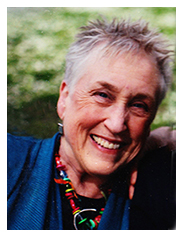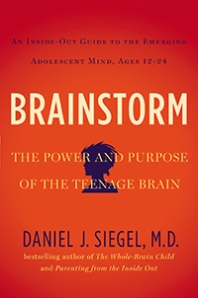Vicky Kelman, March 2014
Brainstorm: the Power and the Purpose of the Teenage Brain by Daniel J. Siegel
 This is a kind of revolutionary “read” (for me, at least) on the life of teenagers. And, therefore, of course, on the lives of all those who all live with them or work with them.
This is a kind of revolutionary “read” (for me, at least) on the life of teenagers. And, therefore, of course, on the lives of all those who all live with them or work with them.
What I took away most strongly from this book is the idea that the teenage years are best thought of as a “remodeling period,” (p. 99) rather than as a “crazy” period.
In discussing this idea with a group of parents of teens recently, those who had experienced a house-remodel (or seen someone go through it) mentioned these aspects: it’s harder than you think it will be, it’s messy, there are always surprises, it takes longer than you think, it never goes as planned, sometimes someone has to move out, you are not prepared even though you think you are but you stick with it for the imagined end product.
 The problem with “crazy” is that it stigmatizes the teen and creates distance whereas the idea of living through a re-model is more neutral and can create more understanding (perhaps [but no promises] making some things easier).
The problem with “crazy” is that it stigmatizes the teen and creates distance whereas the idea of living through a re-model is more neutral and can create more understanding (perhaps [but no promises] making some things easier).
If we can understand this idea of “remodeling,” which has its roots in brain changes during these years, it can free us to witness the amazing growth taking place in this period of life, rather than to dwell on the commotion and chaos wrought by the changes. (Easier said than done.)
This stance requires dispensing of what Siegel identifies three of “the myths,” that are told and re-told about adolescence:
- It’s the raging hormones: hormones do increase but most of what goes on in adolescence that we see as “crazy” and attribute to hormones, is actually a result of changes going on in the adolescent brain
- Teens are immature and just need to grow up: the idea that everyone just need to endure this phase is very limiting. In fact, adolescents can thrive because of this phase of brain growth as the core character traits that build them as adults begin to emerge
- Growing up requires moving from dependence to independence: In fact, though the push toward independence is strong, adolescents still benefit from relationships with adults. It’s better thought of as a movement toward interdependence. (pp 2-3)
Rather than just waiting out this period of adolescence or wading through it as if through a bed of quicksand, Siegel suggests trying to observe the amazing leaps in growth and ability that take place because the brain is growing as it is and trying to see the seeds of the adult that is emerging.
“During adolescence there is increase in the activity of neural circuits using dopamine, a neural transmitter central in creating our drive for reward. Starting in early adolescence and peaking midway through, this enhanced dopamine release causes adolescents to gravitate toward thrilling experiences and exhilarating sensations….the brain’s increased drive for reward in adolescence manifests in teens’ lives in three important ways.” ( p. 67)
- impulsiveness: jumping into action without pausing to think (about other options, about consequences)
- increased susceptibility to addiction: new experiences (substances) are likely to lead to a robust dopamine high, followed by a drop which then can lead to seeking that high again
- hyperrationality: a kind of literal, concrete thinking which takes into account only the possible benefits of a chosen course of action, ignoring the risks and possible negatives, even if they are known
According to Siegel, the work of the adolescent brain is to integrate different areas of brain function. This is a process that is both physical and chemical. An outcome of this integration is the growth of fibers of cognitive control that ultimately decrease impulsivity, affording more space in the mind to pause and consider and think in place of that impulsive jump. It also enables the development of big picture thinking (which Siegel calls “gist thinking”).
At the same time the brain is both reducing the number of basic cells, neurons, and their connections, a process he calls “pruning.” This seems to be influenced o by a combination of genetics, experience and stress.
At the same time, the brain is laying down myelin, a sheath covering the membranes among interlinked neurons. This sheath enables the passage of electrical flow among the remaining linked neurons, permitting faster and more efficient flow of information.
Pruning and myelination help the adolescent brain become more integrated. The brain is more coordinated. “Gist” thinking develops. (pp 81-83)
Siegel believes that much of this brain development can be aided and affected by experience, that parents and teachers have a role to play in nurturing this growth toward adulthood. But that means active engagement with teens rather than reading them off as “crazy” or “immature.” It means talking with them, co-thinking with them, being present for them, rather than passively waiting for these years to end. Parents need to step back but not away.
Adolescence is a glorious and fascinating phase of figuring out who you are (which as we know is never really finished) that gets its healthy start in these years between 12-24. To help his readers, Siegel has structured his book so that every other chapter is composed of a set of “mind-sight tools,” (sort of brain-exercises) for practicing and supporting the kinds of integration that the brain is undergoing during adolescence (and beyond).
In reflecting on this book through my Jewish lens, I found myself reconsidering Bar and Bat Mitzvah and that discussion that often arises around the proper age for Bar Mitzvah. (“Isn’t 13 too young? Could it/should be moved to 16 or even 18?”)
Under the influence of Brainstorm, I am thinking that 13 is just the right age. Bar or Bat Mitzvah is best understood, not as the time when a person becomes an adult but as the time when this process of becoming an adult (brain maturation) goes into full swing. At that point a child can take on adult responsibilities ( walk the dog, count in a minyan, give tzedakah, prepare dinner for the family) but is still working his/her way toward being an adult.
A text from Avot d’Rabbi Natan (16:2) teaches us that the yetzer haTov (the good inclination) doesn’t even enter a person until bar/bat mitzvah, at which point it tangles with the Yetzer haRa (the negative inclination), which is in-born. This means that a post Bar/Bat mitzvah teen can be held responsible for his/her actions in a way that could not be true of his/her younger self (because there was no Yetzer HaTov present.) It’s the opposite of what we might otherwise think. We think of the “innocent” child later spoiled by the world, but this text flips that view. A child can’t be held responsible because there is no countervailing force. Entering adolescence means increasing responsibility for mediating these opposing forces within. As the brain develops, more control is gained over the self, who you are becoming and the world around you. This internal struggle, instigated by the arrival of the Yetzer haTov, can be understood as the brain growth we see in the time frame we call adolescence.
End goal?
Keeping in mind that it doesn’t “just happen” but requires presence and attention from caring adults : “Integration [within the brain] is what creates the master functions of self-awareness, reflection, planning decision-making, empathy and even morality – thinking about the larger social good.” (p. 106)
In other words: a mensch.
Two notes:
- Siegel has written this book for teen readers and for adult readers and this dual form of address sometimes yields some awkwardness.
- There are no footnotes and no bibliography (an absence I found disappointing).

